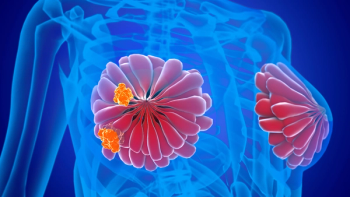
- December 2025
- Volume 19
- Issue 4
FDA Approves Imlunestrant in ESR1+ ER+, HER2- Metastatic Breast Cancer
The FDA has approved imlunestrant for the treatment of patients with ESR1-mutated ER+, HER2- metastatic breast cancer.
The FDA has granted approval to imlunestrant (Inluriyo) for use in adult patients with estrogen receptor (ER)-positive, HER2-negative advanced or metastatic breast cancer with ESR1 mutations whose disease progressed following one or more lines of endocrine therapy, according to a news release from Eli Lilly and Company, the developer of imlunestrant.1
The oral ER antagonist’s approval is based on data on patients with
Patients included in the trial (n = 256) were given either imlunestrant or endocrine therapy in one of 2 contexts:
- As a frontline therapy for metastatic disease after recurrence on adjuvant aromatase inhibitor with or without CDK4/6 inhibitor (21%)
- Or as a second-line treatment for metastatic disease after progression on an aromatase inhibitor with or without previous treatment with a CDK4/6 inhibitor (79%).
This marks imlunestrant’s first FDA approval. The ER antagonist is available in 200-mg tablets. It is recommended as a once-daily dose of 400 mg taken orally on an empty stomach, meaning patients should take it 2 or more hours before food or 1 hour after.
What Should Nurses Know About Imlunestrant?
Changes to complete blood counts were commonly reported in patients taking imlunestrant. The most frequently observed adverse effects (AEs) in those receiving imlunestrant, occurring in at least 10% of patients, included decreased hemoglobin (30%), musculoskeletal pain (30%), hypocalcemia (26%), neutropenia (26%), elevated aspartate aminotransferase (25%), fatigue (23%), diarrhea (22%), elevated alanine transaminase (21%), hypertriglyceridemia (21%), nausea (17%), thrombocytopenia (16%), constipation (10%), elevated cholesterol (10%), and abdominal pain (10%).
Serious AEs were reported in 10% of patients. The only serious AE reported in more than 1% of patients was pleural effusion (1.2%).
Fatal AEs occurred in 1.8% of patients; causes included cardiac arrest, acute myocardial infarction, right ventricular failure, hypovolemic shock, and upper gastrointestinal hemorrhage. Each fatal AE occurred in 0.3% of patients.
Because imlunestrant is a CYP3A substrate, concomitant use of imlunestrant with a strong
The label for
In an interview with Oncology Nursing News, Komal Jhaveri, MD, FACP, a breast medical oncologist and early drug development specialist at Memorial Sloan Kettering Cancer Center in New York, New York, explained that having an additional
“There are some differences if we think about this same class of drugs. When we think about imlunestrant, it’s more of a pure ER antagonist and a degrader,” said Jhaveri. “When we think about elacestrant, it has both SERM- and SERD-like properties.”
Regarding the safety profiles of the 2 therapies, Jhaveri explained that while elacestrant is associated with more nausea than imlunestrant, patients receiving imlunestrant have also experienced nausea, fatigue, and vomiting, which were largely grade 1 and easily managed. She added that lipid monitoring is another key difference in the agents.
“There was some hypercholesterolemia that was seen with elacestrant, so we have to [monitor lipids] when we start patients on elacestrant,” said Jhaveri. “We don’t have to have that monitoring done with imlunestrant, which had a slightly lower incidence of hypercholesterolemia.”
What’s Next for Imlunestrant?
Imlunestrant is being actively investigated vs standard hormone therapy in patients with early ER-positive, HER2-negative breast cancer following treatment with endocrine therapy for 2 to 5 years and a higher-than-average risk of recurrence in the phase 3 EMBER-4 trial (NCT05514054).2 EMBER-4 is active and recruiting.2
Imlunestrant’s phase 1 EMBER trial (NCT04188548), which investigated its safety and efficacy in breast and endometrial cancers, is ongoing but no longer recruiting.3 EMBER-3 is also ongoing.1
Prior to imlunestrant’s approval, elacestrant was the only FDA-approved therapy for patients with
References
- U.S. FDA approves Inluriyo (imlunestrant) for adults with ER+, HER2-, ESR1-mutated advanced or metastatic breast cancer. News release. Eli Lilly and Company. September 25, 2025. Accessed September 25, 2025. https://investor.lilly.com/news-releases/news-release-details/us-fda-approves-inluriyo-imlunestrant-adults-er-her2-esr1
- A study of imlunestrant versus standard endocrine therapy in participants with early breast cancer (EMBER-4). ClinicalTrials.gov. August 24, 2022. Updated October 16, 2025. Accessed October 25, 2025. https://clinicaltrials.gov/study/NCT05514054
- A study of LY3484356 in participants with advanced or metastatic breast cancer or endometrial cancer (EMBER). ClinicalTrials.gov. December 6, 2019. Updated June 4, 2025. Accessed September 25, 2025. https://www.clinicaltrials.gov/study/NCT04188548
- FDA approves elacestrant for ER-positive, HER2-negative, ESR1-mutated advanced or metastatic breast cancer. FDA. January 27, 2023. Accessed September 25, 2025. https://www.fda.gov/drugs/resources-information-approved-drugs/fda-approves-elacestrant-er-positive-her2-negative-esr1-mutated-advanced-or-metastatic-breast-cancer
Articles in this issue
Newsletter
Knowledge is power. Don’t miss the most recent breakthroughs in cancer care.





















































































